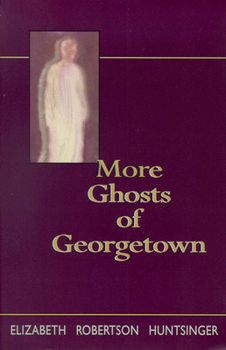More Ghosts of Georgtown
Select Format
Select Condition 
Book Overview
If you visit Pawleys Island, you may be greeted by a pair of friendly terriers frolicking at the edge of the ocean. If you find yourself at Wedgefield Plantation on a moonlit night, on the other hand, you may come face to face with a pistol-packing soldier amid the sound of hoofbeats and gunfire. You should feel neither welcomed nor threatened, however, for things are not always as they seem in Georgetown County, South Carolina. The Pawleys Island terriers and the British soldier of Wedgefield are merely a sampling of the ghosts that reside in one of America's most haunted places. Readers of the 19 stories in More Ghosts of Georgetown will hear moans from the sunken Union flagship Harvest Moon and the thump of a peg leg on an empty floor of the Rice Museum. They will see the lights of a long-lost schooner off Murrells Inlet and witness the agony of a Georgetown County hag as she wriggles out of her salt-soaked skin. From the Hanging Tree at Lamberttown to the mysterious light of Lucas Bay, they will visit a place supernatural like no other. Elizabeth Huntsinger is a South Carolina native whose mother's family came to the state in the 1600s and whose father immigrated there from Scotland. Her first home in Georgetown County was a 1948-vintage 40-foot mahogany Chris Craft boat anchored in the Waccamaw River. Now a landlubber, she lives in a neighborhood built on the site of one of the area's many rice plantations. In addition to being a full-time storyteller/literacy instructor for Georgetown County preschoolers, she leads Ghosts of Georgetown Lantern Tours and is an avid Civil War re-enactor.
Format:Paperback
Language:English
ISBN:0895872099
ISBN13:9780895872098
Release Date:January 1998
Publisher:Blair
Length:167 Pages
Weight:0.50 lbs.
Dimensions:0.6" x 5.2" x 8.0"
Customer Reviews
2 ratings
Beware the Plat-Eyes
Published by Thriftbooks.com User , 19 years ago
Elizabeth Robertson Huntsinger published her first book of Georgetown ghost stories in 1995 and followed it with this volume in 1998. In many ways this book resembles it's predecessor except that the writing style is much better in this entry. It is indeed very obvious that Mrs. Huntsinger has grown as an author and that is quite a feat considering that her first venture was very well written. Her first book contained hardly any first person accounts of hauntings and although this entry could use a few more of these eyewitness accounts they are certainly more in evidence in this book than in the last. There are a couple of chapters that don't deal with ghosts in a real way but those chapters aren't all that distracting and the chapter dealing with Hags and Plat-Eyes is completely understandable since these two entities are such a staple of Southern lore. The area around Georgetown was a leading rice producing area before the Civil War and many of the stories contained in this book come from the old rice plantations of Georgetown County. Throw in a pirate or two, a haunted lighthouse and a headless British soldier and you have the recipe for a very good ghost book. One would have to wonder how this author could fail to produce an interesting book with such fine material to work with but I can assure you that many authors could fall flat on their faces with this material. Mrs. Huntsinger does an admirable job of telling these stories and she does so with the charm of a real Southern lady. She has an enthusiasm for her subject and a fondness for the area that come through loud and clear in her writing and this combination is always a distinct plus in this genre of book. This book will definitely accompany me on my next trip to the South Carolina low country so that I can follow the directions the author so kindly provides to the sites she discusses. Then maybe, just maybe I will see the Terriers of Pawleys Island or the floating coffin of Kinloch Plantation for myself.
Even better than the original!
Published by Thriftbooks.com User , 25 years ago
After reading "Ghosts of Georgetown" for the first time, I had to read the second one. This was even better.






